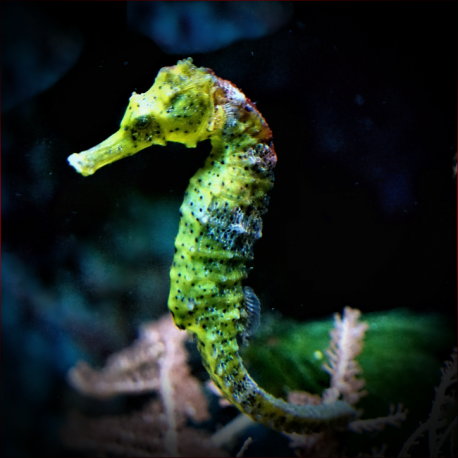More info
Datasheet
| Minimum Tank Size | 113 litres / 29.85 US gallons |
| Maximum Size | 17.8cm / 7.01inches |
| Reef Compatible | With Caution |
| Temperament | Peaceful |
| Care Description | Difficult |
| Specific Gravity | 1.021-1.025 |
| Carbonate Hardness | 8-12 |
| pH | 8.0-8.4 |
General Description
The Lined Seahorse, Hippocampus erectus, is a striking fish highly regarded for its attractiveness among hobbyists. Found in a variety of habitats in the Western Atlantic Ocean along the East coast of the United States, these seahorses exhibit coloration ranging from black to gray to brown, often influenced by their surroundings.
Aquarium Suitability
Demands: Considered challenging to care for, the Lined Seahorse thrives best when housed as a mated pair or in a small group in a species-only tank of at least 30 gallons, with a taller tank being preferable for optimal water circulation. Compatibility wise, they coexist well with docile species like gobies and firefish but should not be housed with aggressive or fast-moving tankmates.
Care and Hardiness
The Lined Seahorse requires delicate care and attention, particularly in terms of feeding, as they are slow, deliberate eaters preferring multiple small feedings daily. Introducing live saltwater feeder shrimp is recommended to encourage feeding, with frozen mysis shrimp being a suitable dietary staple. They also consume amphipods and small crustaceans found in live rock.
Reef Suitability
With caution, Lined Seahorses can be housed in reef aquariums, but careful consideration should be given to their tankmates to ensure they are not outcompeted for food or subjected to harassment.
Aquarium Setup
A species-only tank of at least 30 gallons, with a height of at least 16 inches for adequate water circulation, is ideal for housing Lined Seahorses. Providing suitable tankmates such as gobies and firefish is essential for their well-being.
Behaviour
Seahorses, including the Lined Seahorse, are known for their unique behavior of clinging to seagrass with their prehensile tail instead of actively swimming. They exhibit captivating courtship rituals when mating, culminating in the male giving birth to a brood of miniature seahorses.
Feeding and Diet
Carnivorous in nature, Lined Seahorses feed on a diet of live and frozen shrimp, as well as small crustaceans like amphipods found in live rock. Care should be taken to provide varied and vitamin-enriched meals to ensure their nutritional needs are met.
Dimorphism
In terms of dimorphism, male Lined Seahorses impress females with vibrant color displays and energetic pouch exhibitions during courtship. Once mated, the male can carry as many as 600 eggs in its pouch, giving birth to miniature replicas of the pair approximately 14 days later.
Habitat and Distribution
Hippocampus erectus, the Lined Seahorse, can be found inhabiting a range of habitats in the Western Atlantic Ocean, particularly along the East coast of the United States. Their distribution includes areas with seagrass beds and other shallow marine environments.

